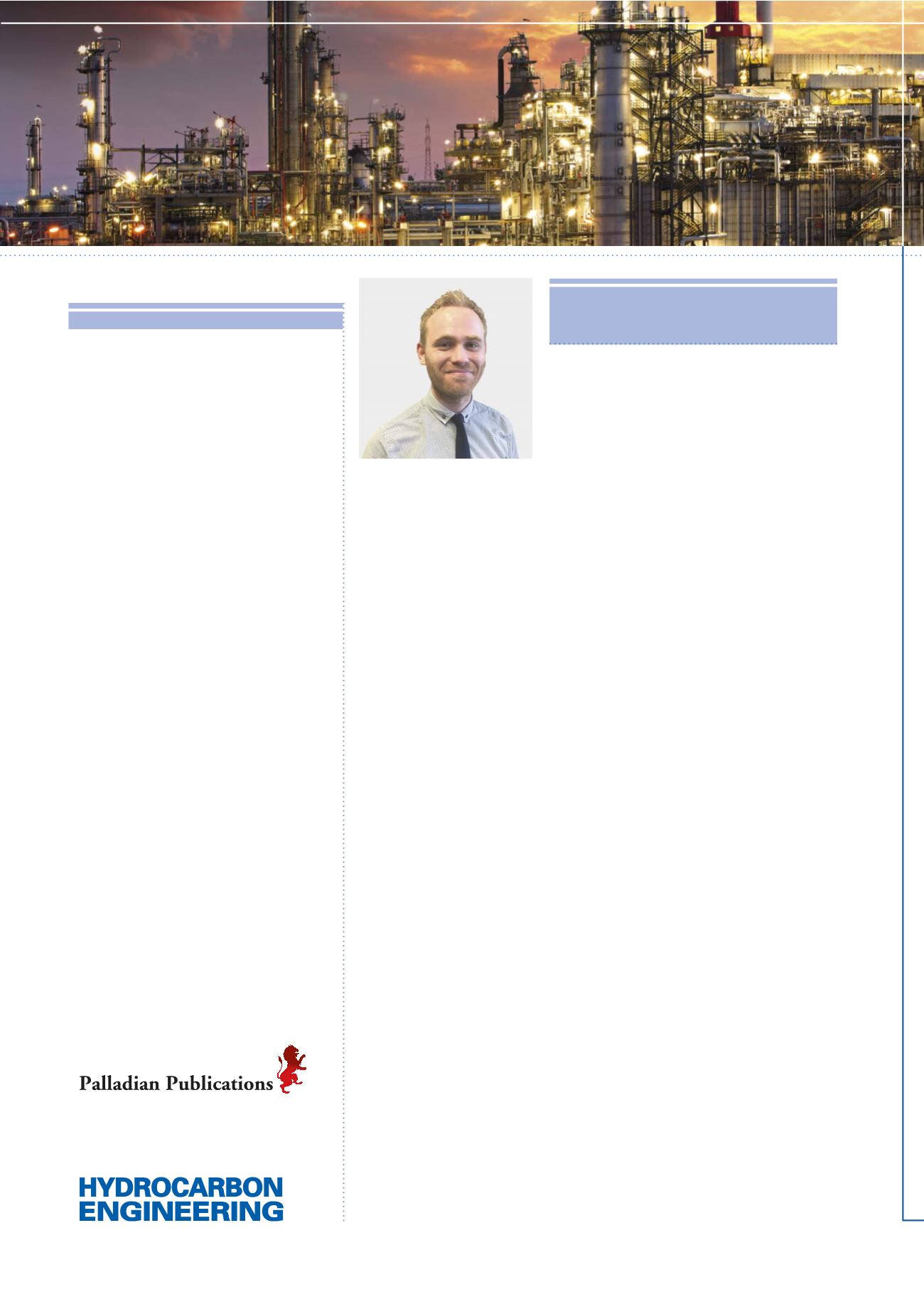
CONTACT INFO
MANAGING EDITOR
James Little
james.little@hydrocarbonengineering.comSENIOR EDITOR
Callum O'Reilly
callum.oreilly@hydrocarbonengineering.comEDITORIAL ASSISTANT
Tom Mostyn
tom.mostyn@hydrocarbonengineering.comSALES DIRECTOR
Rod Hardy
rod.hardy@hydrocarbonengineering.comSALES MANAGER
Chris Atkin
chris.atkin@hydrocarbonengineering.comSALES EXECUTIVE
Sophie Barrett
sophie.barrett@hydrocarbonengineering.comPRODUCTION MANAGER
Ben Munro
ben.munro@hydrocarbonengineering.comWEB MANAGER
Tom Fullerton
tom.fullerton@hydrocarbonengineering.comDIGITAL EDITORIAL ASSISTANT
John Williams
john.williams@hydrocarbonengineering.comDIGITAL EDITORIAL ASSISTANT
Naomi Holliman
naomi.holliman@hydrocarbonengineering.comADMIN MANAGER
Laura White
laura.white@hydrocarbonengineering.comCONTRIBUTING EDITORS
Nancy Yamaguchi Gordon Cope
SUBSCRIPTION RATES
Annual subscription £110 UK including postage
/£125 overseas (postage airmail).
Two year discounted rate £176 UK
including postage/£200 overseas (postage airmail).
SUBSCRIPTION CLAIMS
Claims for non receipt of issues must be made within 3 months of
publication of the issue or they will not be honoured without charge.
APPLICABLE ONLY TO USA & CANADA
Hydrocarbon Engineering (ISSN No: 1468-9340, USPS No: 020-998) is
published monthly by Palladian Publications Ltd GBR and distributed
in the USA by Asendia USA, 17B S Middlesex Ave, Monroe NJ 08831.
Periodicals postage paid New Brunswick, NJ and additional mailing
offices. POSTMASTER: send address changes to HYDROCARBON
ENGINEERING, 701C Ashland Ave, Folcroft PA 19032.
15 South Street, Farnham, Surrey
GU9 7QU, ENGLAND
Tel: +44 (0) 1252 718 999Fax:
+44 (0) 1252 718 992COMMENT
CALLUM O'REILLY
SENIOR EDITOR
L
ast month, we celebrated the 50
th
anniversary of one of mankind’s greatest
achievements: the Apollo 11 moon landing,
which took place on 20 July 1969.
While doing some research into the essential
role that our industry played in the success
of this project, I stumbled upon a very interesting blog by Jim Cooper, Senior
Petrochemical Advisor for American Fuel & Petrochemical Manufacturers (AFPM).
1
Jim outlines exactly why the mission would not have been possible without our
sector, and he’s not even referring to the kerosene that was used as rocket fuel to
actually get man to the moon...
Once in space, the astronauts required special suits to survive the harshest
of environments, and petrochemicals provided the building blocks that made
the advanced materials for these space suits possible. Jim goes on to explain
how Neil Armstrong’s suit was composed of 21 different layers of synthetic
materials, most of which used petrochemicals as the basis for their manufacture.
The outer layers were made from materials including Teflon
®
(a brand name
for polytetrafluoroethylene [PTFE], which is made from chloroform derived
from methane); aluminised Kapton
®
(a polymide film made from benzene and
mixed xylenes); and Mylar
®
(a special type of polyester that uses ethylene and
paraxylene). Following a four-layer spacer made from non-woven Dacron
®
polyester, the inner layers of the suit included materials such as neoprene-coated
nylon (neoprene is made from butadiene, while nylon uses butadiene as well as
benzene) and polyester laminated with polyurethane (made using benzene or
toluene, as well as ethylene and paraxylene). On top of all that, the space suit
included a liquid cooling garment made out of Spandex, and used vinyl tubing
made out of polyvinyl chloride (the primary building block of which is ethene).
If all that wasn’t enough, we also have the space helmets, which are made from
materials that rely upon petrochemicals. And it is important to remember that
modern space suits use a variety of petrochemical-dependent advanced materials
that were not available when designing the kit for the Apollo 11 crew.
All of this serves to remind us of the essential – although often forgotten – role
that petrochemicals play in so many different aspects of life, both on planet Earth
and beyond.
For more details on the suits worn by the Apollo 11 team, I’d encourage you to
read Jim’s full blog on the AFPM website (details can be found at the bottom of
this page). We have also included a link to this story on
Hydrocarbon Engineering
’s
new LinkedIn Showcase page, which can be found at
www.linkedin.com/showcase/hydrocarbonengineeringmagazine.
If you’re a member of LinkedIn, I’d encourage you to join our community.
In addition to publishing the latest news highlights from our website
(www.hydrocarbonengineering.com) and snippets from upcoming issues of the
magazine, we regularly delve into issues past and reflect upon how our industry
has developed throughout the years. Our Showcase page is also a great way to
interact with our content (and fellow readers) and let us know about any features
that you would like to see more of in the year ahead.
1. COOPER, J., ‘One small step for man, one giant leap for petrochemicals’, AFPM, (19 July 2019),
https://www.afpm.org/newsroom/blog/one-small-step-man-one-giant-leap-petrochemicals-0







